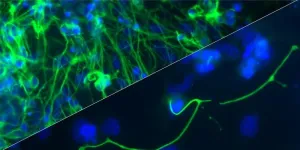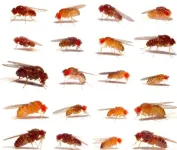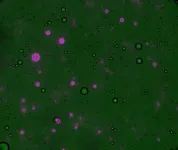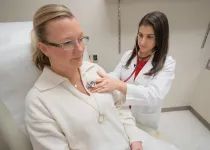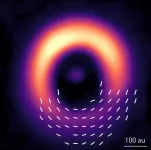(Press-News.org) How would you summarize your study for a lay audience?
Heart failure remains a substantial burden for patients due to its high prevalence and limited therapeutic options. Heart failure is classified into two major clinical subtypes— heart failure with preserved ejection fraction (HFpEF) and heart failure with reduced ejection fraction (HFrEF). While there have been significant therapeutic advances in HFrEF, the rate of complications and death from HFrEF remains high. Additionally, most drugs that have shown benefits for patients with HFrEF have not demonstrated a comparable benefit in patients with HFpEF, highlighting a critical need for the development of targeted therapies for both subtypes.
In our new study, we analyzed a large genetic dataset and used multi-omics to identify 58 novel drug targets for both HFpEF and HFrEF. Our findings have the potential to guide the development of effective drugs for patients with different types of heart failure.
What methods or approach did you use?
We used a large-scale multi-omics approach to analyze genetic data from 55,378 patients with HFpEF and HFrEF from the Veterans Affairs (VA) Million Veteran Program (MVP). We leveraged transcriptomics and proteomic data to analyze over 15,000 genes to identify targets with causal relevance to both HFpEF and HFrEF.
For each gene identified as a potential therapeutic target through our analyses, we further explored additional biological evidence to strengthen the causal link between protein and heart failure subtype. Then we validated our findings in a multi-ancestry genetics dataset of 175,000 individuals of African American, Hispanic and European-descent and replicated the results using an alternative proteomics platform.
What did you find?
From our evaluation, we identified 70 genes associated with HFrEF and 10 genes associated with HFpEF. Notably, the drug targets for HFpEF and HFrEF did not overlap, highlighting the importance for developing subtype-specific therapeutic strategies.
Among the genes identified, we found several with strong potential for novel drug discovery. Additionally, we identified several genes that, when targeted, may be suitable for drug repurposing for both subtypes of heart failure.
What are the implications?
Our findings reveal promising opportunities for both drug development and drug repurposing. We anticipate that our identification of several genes as putative therapeutic targets for HFpEF and HFrEF will be of value in the development of novel therapeutic strategies for these conditions.
What are the next steps?
We will need to conduct experimental studies using new datasets to further explore the biological mechanisms underlying these targets, particularly those with limited prior biological evidence. These types of studies will be critical to validate the therapeutic potential of the identified targets and advancing them toward clinical application.
Authorship: In addition to Rasooly, Mass General Brigham authors include Hesam Dashti, Daniel Golden, Andrea R. V. R. Horimoto, Kelly Cho, J. Michael Gaziano and Alexandre C. Pereira
Paper cited: Rasooly D et al., “Large-scale multi-omics identifies drug targets for heart failure with reduced and preserved ejection fraction” Nature Cardiovascular Research DOI: 10.1038/s44161-025-00609-1
Funding: This work was supported by the Million Veteran Program (#MVP037 [BLR&D Merit Award BX005831] and #MVP001 [I01-BX004821]), a Veterans Affairs Grant (I01CX001922), a VA Merit Grant (I01-CX001025), the British Heart Foundation (PG/14/89/31194), the National Institute of Health and Care Research Barts Biomedical Research Centre (NIHR203330), the UK Research and Innovation (UKRI) Programme Grant (MC_UU_00002/18), “SmartHeart” EPSRC Programme Grant (EP/P001009/1) and the Medical Research Council (MR/X020924/1).
Disclosures: This publication does not represent the views of the Department of Veterans Affairs or the United States Government. Steffen E. Petersen provides consultancy to Circle Cardiovascular Imaging, Inc., Calgary, Alberta, Canada. John Whittaker holds membership of scientific advisory boards/consultancy for Relation Therapeutics and Silence Therapeutics and ownership of GSK shares. Juan P. Casas is employed full-time by the Novartis Institute of Biomedical Interest (his major contributions to this project were while employed at VA Boston Healthcare System).
END
Research spotlight: Researchers identify potential drug targets for future heart failure therapeutics
2025-02-06
ELSE PRESS RELEASES FROM THIS DATE:
Air pollution clouds the mind and makes everyday tasks challenging
2025-02-06
People’s ability to interpret emotions or focus on performing a task is reduced by short-term exposure to particulate matter (PM) air pollution, potentially making everyday activities, such as the weekly supermarket shop, more challenging, a new study reveals.
Scientists discovered that even brief exposure to high concentrations of PM may impair a person’s ability to focus on tasks, avoid distractions, and behave in a socially acceptable manner.
Researchers exposed study participants to either high levels of air pollution - using candle smoke - or clean air, testing cognitive abilities ...
Uncovering how developmental genes are held in a poised state
2025-02-06
Key points:
Researchers from the Voigt lab have extended our understanding of how developmental genes are held in a poised state to allow timely expression once they receive the correct ‘go’ signals.
The next layer of regulation has been uncovered by the identification of proteins that interact with the epigenetic marks that poise developmental genes ready for expression.
The research provides insight into the mechanisms through which the phenomenon of bivalency – where both activating and repressive marks are laid down at the same site on the genome – acts to ready developmental ...
Multimillion-pound research project aims to advance production of next-generation sustainable packaging
2025-02-06
A multimillion-pound research project, called SustaPack, aims to overcome manufacturing challenges for the next generation of sustainable, paper-based packaging for liquids. Backed by a £1 million grant from the Engineering and Physical Sciences Research Council (EPSRC) as part of UKRI’s co-investing programme, packaging technology company Pulpex Ltd has joined forces with the University of Surrey to refine its manufacturing processes to provide a viable solution to plastic pollution.
Contributing matching support towards the project, Pulpex has already made significant strides in the development of its patented technology, ...
‘Marine Prosperity Areas’ represent a new hope inconservation
2025-02-06
Could 2025 be the year marine protection efforts get a “glow up”? According to a team of conservation-minded researchers, including Octavio Aburto of UC San Diego’s Scripps Institution of Oceanography, the moment has arrived.
In a new study published Feb. 6 in the journal Frontiers in Marine Science, Aburto and a multinational team of marine scientists and economists unveil a comprehensive framework for Marine Prosperity Areas, or MPpAs. With a focus on prosperity—the condition ...
Warning signs may not be effective to deter cannabis use in pregnancy: Study
2025-02-06
PISCATAWAY, NJ – Warning signs at dispensaries about the potential health effects of cannabis use in pregnancy may not be effective, according to a new report in the Journal of Studies on Alcohol and Drugs, based at Rutgers University. In fact, those who are pregnant and using cannabis may actually distrust the content of warning signs altogether.
“Mandatory warning signs aren’t working,” says lead researcher Sarah C. M. Roberts, DrPH, of the University of California, San Francisco. In fact, some of the respondents “saw the signs as having stigmatizing or negative effects on pregnant people who use ...
Efforts to find alien life could be boosted by simple test that gets microbes moving
2025-02-06
Finding life in outer space is one of the great endeavors of humankind. One approach is to find motile microorganisms that can move independently, an ability that is a solid hint for life. If movement is induced by a chemical and an organism moves in response, it is known as chemotaxis.
Now, researchers in Germany have developed a new and simplified method for inducing chemotactic motility in some of Earth’s smallest life forms. They published their results in Frontiers in Astronomy and Space Sciences.
“We tested three types of microbes – two bacteria and one type of archaea – and found that they all moved toward a chemical called L-serine,” ...
Study shows some species are susceptible to broad range of viruses
2025-02-06
A study of fruit flies shows some species are highly susceptible to a wide range of viruses.
In the study – by the University of Exeter – 35 fruit fly species were exposed to 11 different viruses of diverse types.
As expected, fly species that were less affected by a certain virus also tended to respond well to related viruses.
But the findings also show “positive correlations in susceptibility” to viruses in general. In other words, fly species that were resistant to one virus were generally resistant to others – including very different ...
How life's building blocks took shape on early Earth: the limits of membraneless polyester protocell formation
2025-02-06
One leading theory on the origins of life on Earth proposes that simple chemical molecules gradually became more complex, ultimately forming protocells—primitive, non-living structures that were precursors of modern cells. A promising candidate for protocells is polyester microdroplets, which form through the simple polymerisation of alpha-hydroxy acids (αHAs), compounds believed to have accumulated on early Earth possibly formed by lightning strikes or delivered via meteorites, into protocells, followed by simple rehydration ...
Survey: Many Americans don’t know long-term risks of heart disease with pregnancy
2025-02-06
COLUMBUS, Ohio – Pregnancy-related deaths in the U.S. have risen 140% over the past three decades with heart disease a major cause, according to the American Heart Association. A new national survey commissioned by The Ohio State University Wexner Medical Center found that many Americans are not aware of the long-term risks of heart disease with pregnancy and the critical care needed before, during and after pregnancy.
“During pregnancy there are a lot of different hormone shifts that happen to accommodate growth of the baby and health of the mom. The result is that the mom’s heart rate increases along with the amount ...
Dusting for stars’ magnetic fingerprints
2025-02-06
For the first time astronomers have succeeded in observing the magnetic field around a young star where planets are thought to be forming. The team was able to use dust to measure the three-dimensional structure “fingerprint” of the magnetic field. This will help improve our understanding of planet formation.
Planets form in turbulent disks of gas and dust called protoplanetary disks around young stars. It is thought that the first step in planet formation is dust grains colliding and sticking together. The movement of ...
